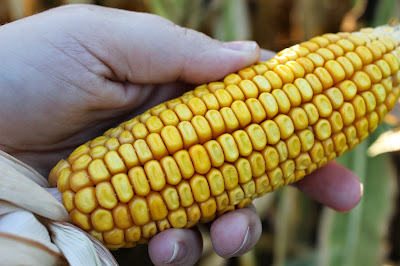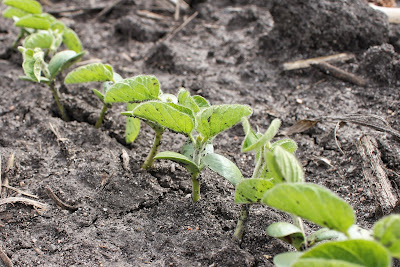Summer is that time of year where we find ourselves in the car a lot. And if you are traveling down a black top road or the Interstate highway in Iowa, there is a good chance you are going to see a lot of two things -
corn and
soybeans. So what are corn and soybeans besides Iowa's two main field crops?
 |
| A field corn cob near harvest in August |
Corn is a tall, stalky, annual field crop. What you are primarily seeing along Iowa's roadways is
Field Corn. Field Corn makes up 98% of the corn grown in the United States. This variety of corn is primarily used for
livestock feed and
ethanol fuel. On our farm we personally sell our corn to both
local cooperatives, who grind the corn for livestock feed, and to
ethanol plants, who extract both fuel for our vehicles and dried distiller's grains (DDGs) to feed to livestock, from the corn kernels. Field corn is also used to make cereal products (corn flour, corn meal, tortillas, etc.), corn starch, corn oil, corn syrup, and even beer and whiskey.
 |
| Here is a picture of some corn starting to emerge last week |
Corn planting has almost reached 100% completion in Iowa and there is a lot that has started to emerge. From your car window right now, corn probably looks like perfect rows of grass. Over the summer, it will grow a strong stalk with long, green leaves and one ear of corn. A typical ear of corn has around 800 kernels on it. By the end of the summer, field corn in Iowa usually is 8 feet tall or higher. (Check out our past family photos on the 4th of July to get an idea of how tall it grows by the half-way point of the growing season -
2014,
2013,
2012)
 |
| A soybean pod near maturity |
Soybeans are a bushy, annual field crop. Soybeans are processed into two products -
soybean meal and
soybean oil. We sell our soybeans to local cooperatives and directly to soybean processors (
in fact, we are hauling soybeans today to Cargill). When soybeans are brought into a processing facility the first thing extracted is the
soybean oil. Soybean oil is a common vegetable oil and it is made into products like margarine and salad dressings. The oil can also go through at refining process and turned into biodiesel fuel. After the oil has been taken out of the seed, s
oybean meal is left. Soybean meal is used for livestock feed, primarily for poultry, pigs and a growing aquaculture (fish) market too.
Soy is a great and high protein source! In fact,
soy is a complete protein; it has eight essential amino acids in it needed for dietary needs of humans and animals.
 |
| Some newly emerged soybeans from today |
Soybean planting isn't as far along in Iowa, compared to corn, but should be close to finished by the beginning of June this year,
if I had to guess. We hope to finish this weekend! Earlier planted soybeans are just now starting to emerge. If you look out your car window and can tell a tractor has been in a field because you see dirt worked up, but don't see anything emerged yet - there's a good chance there are soybeans in it getting ready to pop up out of the ground. Over the summer, the plant will grow many stems that will have green leaflets on them with pods of soybeans. The number of pods on a plant varies from variety to variety and growing season to growing season. In Iowa there are anywhere from 30 to 40 pods on each plant typically. Each pod has an average of three beans.
 |
| Combining soybeans in September |
In the fall both corn and soybeans dry up, and that is when you'll start seeing combines out in the field harvesting the crop. We then sell and deliver our crop to our coops and ethanol plants throughout the year.
So the next time you're taking a road-trip through Iowa, or just a Sunday stroll, I hope you now know a little bit more about what's growing in the fields along the road. I hope you can identify corn and soybeans, and that you might know some fun facts to impress the others in the car! What questions do you have about the corn and soybean growing cycles in Iowa? Remember to
Comment for a Cause!




















.jpg)




